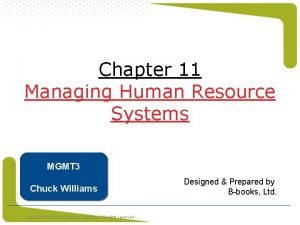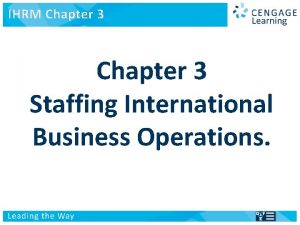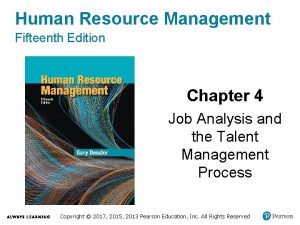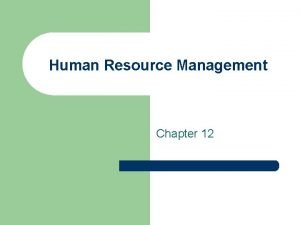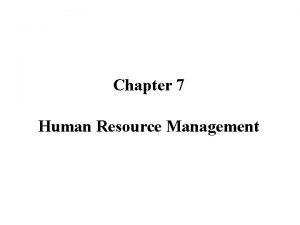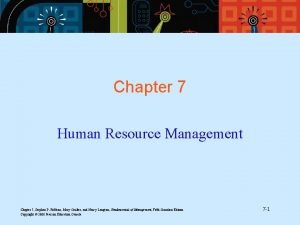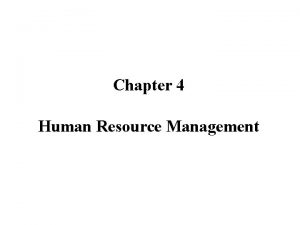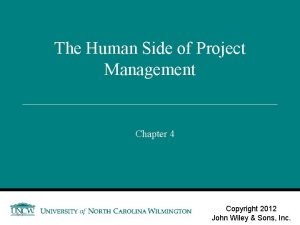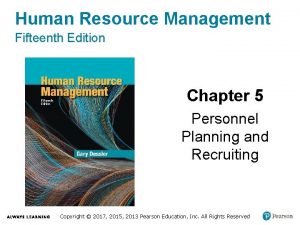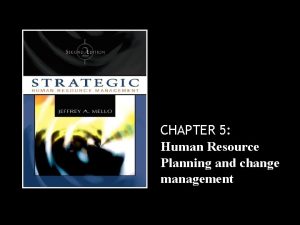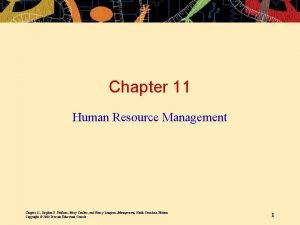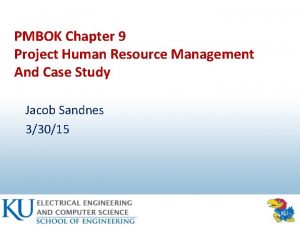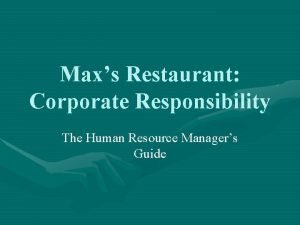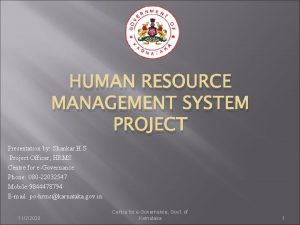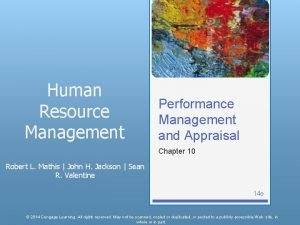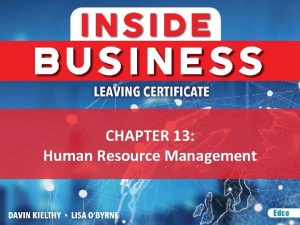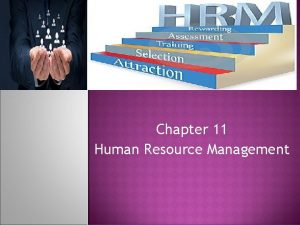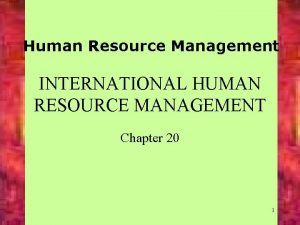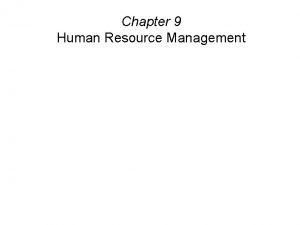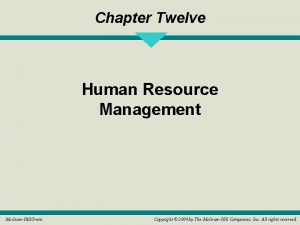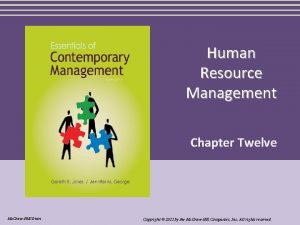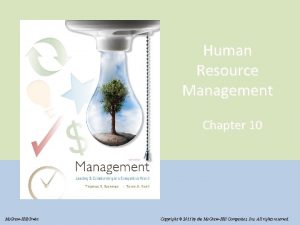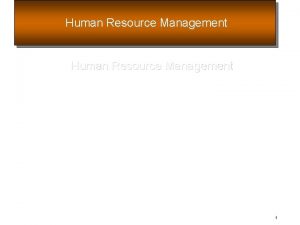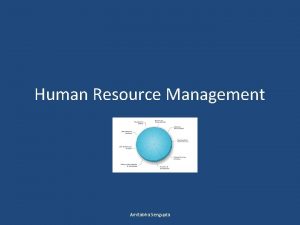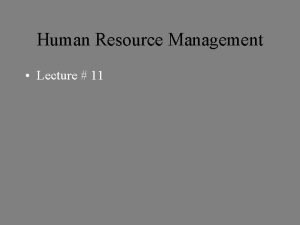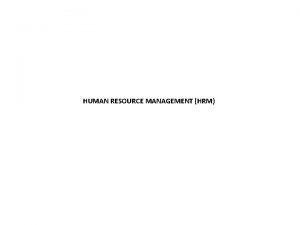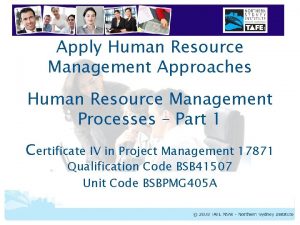Chapter 10 Human Resource Management Mc GrawHillIrwin Copyright


























- Slides: 26

Chapter 10 Human Resource Management Mc. Graw-Hill/Irwin Copyright © 2008 by The Mc. Graw-Hill Companies, Inc. All rights reserved

Slide 2 Learning Objectives After reading this chapter, you should be able to: • Explain the role of human resource management in achieving a sustainable competitive advantage. • Identify the key factors in the environment affecting the management of human resources. • Describe the human resource planning process. • Explain the key components of staffing and their importance. • Describe how training and career development provide employees with tools to succeed once they are hired. • Identify the purposes of performance appraisal and how it might be conducted. • Describe the key objectives of the compensation system and its components. Mc. Graw-Hill/Irwin Copyright © 2008 by The Mc. Graw-Hill Companies, Inc. All rights reserved

Slide 3 Dealing effectively with human resource (HR) issues is essential for all managers. The human resource staff supports managers in carrying out HR responsibilities. Mc. Graw-Hill/Irwin Copyright © 2008 by The Mc. Graw-Hill Companies, Inc. All rights reserved

Slide 4 Environment of Human Resources Workforce Diversity Unions Mc. Graw-Hill/Irwin Globalization Legislation Copyright © 2008 by The Mc. Graw-Hill Companies, Inc. All rights reserved

Slide 5 Key Federal Legislation and Regulations Affecting HR • Social Security Act (1935) • Wagner Act (1935) • Fair Labor Standards Act (1938) • Taft-Hartley Act (1947) • Landrum-Griffin Act (1959) • Equal Pay Act (1963) • Title VII of Civil Rights Act (1964) • Executive Order 11246 (1965) • Age Discrimination in Employment Act (1967) • Wage Garnishment Act (1968) Mc. Graw-Hill/Irwin • • Occupational Safety and Health Act (1970) Vocational Rehabilitation Act (1973) Health Maintenance Organization Act (1973) Employee Retirement Income Security Act (1974) Vietnam-Era Veterans Readjustment Act (1974) Privacy Protection Act (1974) Pregnancy Discrimination Act (1978) Copyright © 2008 by The Mc. Graw-Hill Companies, Inc. All rights reserved

Slide 6 Key Federal Legislation and Regulations Affecting HR (cont) • Job Training Partnership Act (1982) • Consolidated Omnibus Budget Reconciliation Act (1985) • Immigration Reform and Control Act (1986) • Worker Adjustment and Retraining Act (1988) • Drug-Free Workplace Act (1988) • Employee Polygraph Protection Act (1988) Mc. Graw-Hill/Irwin • • Americans with Disabilities Act (1990) Civil Rights Act (1991) • Family and Medical Leave Act (1993) • Health Insurance Portability and Accountability Act (1996) • Small Business Job Protection Act (1996) • Fair Credit Reporting Act (1970, 1996) Copyright © 2008 by The Mc. Graw-Hill Companies, Inc. All rights reserved

Slide 7 Discrimination Employment at Will Sexual Harassment Protected Class Key HR Legislative Issues Affirmative Action Disparate Treatment BFOQ Adverse Impact Job Relatedness Mc. Graw-Hill/Irwin Copyright © 2008 by The Mc. Graw-Hill Companies, Inc. All rights reserved

Unions Slide 8 • Membership has been declining steadily (13% in 2006) • Factors contributing to this decline: ØStrong employer challenges to unions ØPlant closures ØInternational competition ØShrinking manufacturing sector • Labor Contract: Written agreement between union and management that specifies pay schedule, fringe benefits, COLA, and the like. Mc. Graw-Hill/Irwin Copyright © 2008 by The Mc. Graw-Hill Companies, Inc. All rights reserved

Unions (cont) Slide 9 • Union-related legislations: – The Wagner Act (1935) – created the NLRB – The Taft-Hartley Act (1947) – specified a set of unfair labor practices by unions along with the remedies – The Landrum-Griffin Act (1959) – requires each union to report its financial activities and the financial interests of its leaders to the Department of Labor • In the U. S. , labor relations are characterized by: – Business unionism – Job-based unionism – Collective bargaining – Voluntary contracts – Adversarial relationships Mc. Graw-Hill/Irwin Copyright © 2008 by The Mc. Graw-Hill Companies, Inc. All rights reserved

Human Resource Management Process Slide 10 Strategic HR Planning HR Tactics Staffing Mc. Graw-Hill/Irwin Orientation Training Performanc e Appraisal Compensati on and Benefits Career Developme nt Copyright © 2008 by The Mc. Graw-Hill Companies, Inc. All rights reserved

Slide 11 Strategic Human Resource Planning (SHRP) • The development of a vision about where the company wants to be and how it can use human resources to get there. • The ultimate objective of SHRP is a sustained competitive advantage. Mc. Graw-Hill/Irwin Copyright © 2008 by The Mc. Graw-Hill Companies, Inc. All rights reserved

Human Resource Planning Product Demand Labor Productivity Internal Labor Market Labor Demand Slide 12 External Labor Market Labor Supply Conditions and Select 1. Labor demand exceeds labor 2. Labor supply exceeds labor Responses supply § Training or retraining § Succession planning § Promotion from within § Recruitment from outside § Subcontracting § Use of contingent workers § Use of overtime Mc. Graw-Hill/Irwin 3. demand § Pay cuts § Reduced hours § Work sharing § Voluntary early retirements § Inducements to quit § Layoffs Labor demand equals labor supply § Replacement of quits from inside or outside Copyright © 2008 by The Mc. Graw-Hill Companies, Inc. All rights reserved

Staffing Process Slide 13 • Recruitment – the process of generating a pool of qualified candidates for a particular job. • An effective recruitment effort should create a pool of qualified applicants. • Selection – the screening process used to decide which of the applicants to hire. Mc. Graw-Hill/Irwin Copyright © 2008 by The Mc. Graw-Hill Companies, Inc. All rights reserved

Validity and Reliability of Selection Tools Slide 14 • Validity is how well a technique used to assess candidates is related to performance on the job. • Validity can be demonstrated by: ØContent Validity ØEmpirical Validity • Reliability is a measure of the consistency of results of the selection method. Mc. Graw-Hill/Irwin Copyright © 2008 by The Mc. Graw-Hill Companies, Inc. All rights reserved

Slide 15 Application Forms Performance Simulation Tests Psychological Tests Interviews Mc. Graw-Hill/Irwin Letters of Recommendation SELECTI ON TOOLS Ability Tests Personality Tests Honesty Tests Physical Exams Copyright © 2008 by The Mc. Graw-Hill Companies, Inc. All rights reserved

Slide 16 Orientation • Helps new employees to: ØLearn more about the company ØLearn what is expected of them in the job ØReduce the initial anxiety of a transition ØBecome familiar with co-workers ØLearn about work rules and personnel policies Mc. Graw-Hill/Irwin Copyright © 2008 by The Mc. Graw-Hill Companies, Inc. All rights reserved

Slide 17 Employee Training • Training is a planned effort to provide employees with specific skills to improve their performance. • Effective training can also improve morale and increase an organization’s potential. Mc. Graw-Hill/Irwin Copyright © 2008 by The Mc. Graw-Hill Companies, Inc. All rights reserved

Slide 18 The Training Process Develop and Conduct Training Needs Assessment • Organization Needs • Task Needs • Person Needs • Location • Presentation • Type Evaluation Mc. Graw-Hill/Irwin Copyright © 2008 by The Mc. Graw-Hill Companies, Inc. All rights reserved

Training Presentation Techniques Slides and Videotapes Slide 19 Computer-Assisted Instruction (CAI) Classroom Lectures Simulations Cross-functional Training Mc. Graw-Hill/Irwin Vestibule Training Virtual Reality Copyright © 2008 by The Mc. Graw-Hill Companies, Inc. All rights reserved

Slide 20 Career Development • Long-term effort in which the organization helps employees utilize their full potential. • Involves three major phases: ØAssessment ØDirection ØDevelopment Mc. Graw-Hill/Irwin Copyright © 2008 by The Mc. Graw-Hill Companies, Inc. All rights reserved

Slide 21 The Career Development Process Direction • Promotability forecasts • Succession planning • Individual career counseling • Job posting systems • Career resource centers Assessment Development • Mentoring • Coaching • Job rotation • Tuition assistance programs Mc. Graw-Hill/Irwin Copyright © 2008 by The Mc. Graw-Hill Companies, Inc. All rights reserved

Slide 22 Performance Appraisal • Mc. Graw-Hill/Irwin Performance appraisal has three important objectives: Ø Two-way communication between supervisors and employees. Ø Constructive feedback to employees in order to capitalize on strengths and reduce weaknesses. Ø Help managers decide who should be paid more based on contribution. Copyright © 2008 by The Mc. Graw-Hill Companies, Inc. All rights reserved

Slide 23 Approaches to Performance Appraisal Judgment Measure Approaches • Relative judgments • Traits • Absolute judgments • Behavioral anchored rating scales • Outcomes ØMBO Mc. Graw-Hill/Irwin Copyright © 2008 by The Mc. Graw-Hill Companies, Inc. All rights reserved

Slide 24 Compensation • Employees are paid for their contributions to the company. • The three key objectives of the compensation system are to: Ø Ø Ø Attract high-quality workers from the labor market. Retain the best employees the company already has. Motivate employee performance. Mc. Graw-Hill/Irwin Copyright © 2008 by The Mc. Graw-Hill Companies, Inc. All rights reserved

Components of Total Compensation Slide 25 Total Compensation Base Compensation Mc. Graw-Hill/Irwin Pay Incentives Indirect Compensation / Benefits Copyright © 2008 by The Mc. Graw-Hill Companies, Inc. All rights reserved

Slide 26 Compensation System Should: • Fit the firm’s strategic objectives • Fit with the firm’s characteristics and environment • Achieve internal equity (perception of fairness) • Achieve external equity • Be based on employee contributions Mc. Graw-Hill/Irwin Copyright © 2008 by The Mc. Graw-Hill Companies, Inc. All rights reserved
 Time management in human resource management
Time management in human resource management Human resources in retail management process consists of
Human resources in retail management process consists of Management vs human resource management
Management vs human resource management Human resource management chapter 2
Human resource management chapter 2 Chapter 9 human resource management
Chapter 9 human resource management Chapter 11 human resource management
Chapter 11 human resource management New approaches to organizing hr
New approaches to organizing hr Chapter 1 introduction to human resource management
Chapter 1 introduction to human resource management Management fifteenth edition
Management fifteenth edition Human resource management lecture chapter 1
Human resource management lecture chapter 1 Determinants of staffing choices
Determinants of staffing choices Chapter 4 job analysis and the talent management process
Chapter 4 job analysis and the talent management process Functions of hrm
Functions of hrm Chapter 7 human resource management
Chapter 7 human resource management Chapter 7 human resource management
Chapter 7 human resource management Human resource management chapter 4
Human resource management chapter 4 Project management chapter 4
Project management chapter 4 Human resource management chapter 5
Human resource management chapter 5 Human resource management chapter 5
Human resource management chapter 5 Chapter 11 human resource management
Chapter 11 human resource management Project human resource management pmbok ppt
Project human resource management pmbok ppt Resource management pmbok
Resource management pmbok Scope of human resource management
Scope of human resource management Recruitment process of max's restaurant
Recruitment process of max's restaurant Induction hr meaning
Induction hr meaning Human resource management system project ppt
Human resource management system project ppt Mbo performance appraisal method
Mbo performance appraisal method





